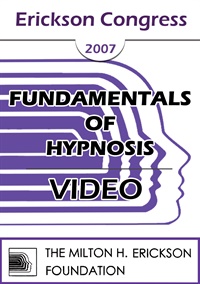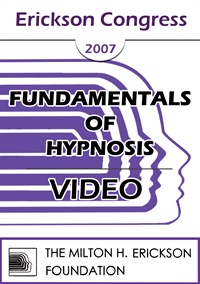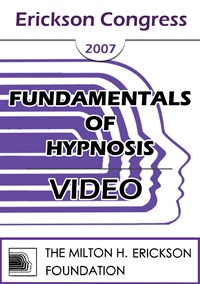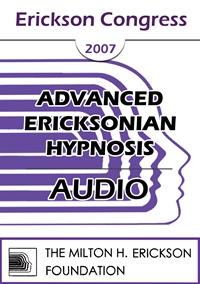
- Average Rating:
- Not yet rated
- Topic Areas:
- Workshops | Hypnosis | Hypnotic Induction | Utilization
- Categories:
- Erickson Congress | Erickson Congress 2007
- Faculty:
- Jeffrey Zeig, PhD
- Duration:
- 2:30:46
- Format:
- Audio Only
- Original Program Date:
- Dec 10, 2007
- Short Description:
- Induction can be a method of delivering therapy, not just a means of eliciting trance. We will explore advanced techniques of utilization, explore advanced techniques of utilization, seeding, motivating and pattern disruption.
- Price:
- $15.00 - Base Price
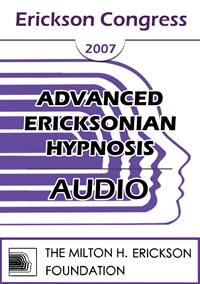
- Average Rating:
- Not yet rated
- Topic Areas:
- Workshops | Confusion Technique | Hypnosis | Indirection | Language of Hypnosis | Binds | Suggestion
- Categories:
- Erickson Congress | Erickson Congress 2007
- Faculty:
- Stephen Lankton, MSW
- Duration:
- 2:50:39
- Format:
- Audio Only
- Original Program Date:
- Dec 10, 2007
- Short Description:
- Participants will be guided through several exercises to help them learn and practice the construction of four forms of confusion technique, bring the number of indirect suggestion to six and the number of therapeutic binds to four. A demonstration using these forms will illustrate the implementations of this set of language techniques for the induction and treatment process.
- Price:
- $15.00 - Base Price
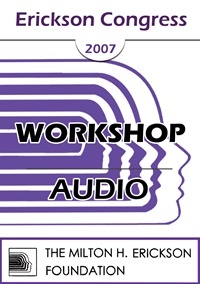
- Average Rating:
- Not yet rated
- Topic Areas:
- Workshops | Communication | Research | Relationships
- Categories:
- Erickson Congress | Erickson Congress 2007
- Faculty:
- Wendel Ray, PhD
- Duration:
- 1:29:27
- Format:
- Audio Only
- Original Program Date:
- Dec 09, 2007
- Short Description:
- Bateson's Research Team and the Palo Alto Group (Jackson, Haley, Weakland, Fry, and Watzlawick) developed Communication Theory. Grounded in 65 years of research, Interactional Focused Clinical Approaches, derived form Communication Theory offer a radically alternative paradigm for understanding human behavior and evoking change. These essential premises and practical interventions techniques will be described.
- Price:
- $15.00 - Base Price
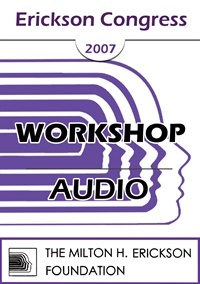
- Average Rating:
- Not yet rated
- Topic Areas:
- Workshops | Storytelling | StoryPlay | Children and Adolescent Therapy | Metaphors | Multicultural
- Categories:
- Erickson Congress | Erickson Congress 2007
- Faculty:
- Joyce Mills, PhD, LMFT
- Duration:
- 1:42:09
- Format:
- Audio Only
- Original Program Date:
- Dec 09, 2007
- Short Description:
- The StoryPlay® model weaves together the elements of story/metaphors, creativity, expressive arts and play to form a unique and proven method of therapy to effect positive change, healing and problem-solving. Deriving its theoretical foundations from the principles of Milton H. Erickson and indigenous teachings, StoryPlay® emphasizes cultural diversity, natural healing abilities and creative solutions.
- Price:
- $15.00 - Base Price
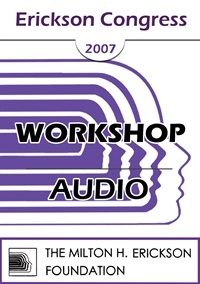
- Average Rating:
- Not yet rated
- Topic Areas:
- Workshops | Ericksonian Hypnosis and Therapy Techniques | Hypnosis | Trance | Utilization
- Categories:
- Erickson Congress | Erickson Congress 2007
- Faculty:
- Eric Greenleaf, PhD | Betty Alice Erickson, MS, LPC, LMFT
- Duration:
- 1:53:02
- Format:
- Audio Only
- Original Program Date:
- Dec 09, 2007
- Short Description:
- This workshop will include demonstrating a smorgasbord of opportunity to engage the patient - the problem, the trance, and solutions; Interviewing for a sense of experiential style, idiosyncratic language and learned skills; Utilizing repeated trances of different sorts by each presenter with a volunteer. This will be interspersed with discussion and practice sessions for participants.
- Price:
- $15.00 - Base Price
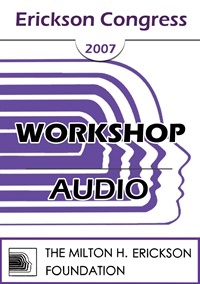
- Average Rating:
- Not yet rated
- Topic Areas:
- Workshops | Utilization | Ericksonian Psychotherapy | Psychotherapy
- Categories:
- Erickson Congress | Erickson Congress 2007
- Faculty:
- Brent Geary, PhD
- Duration:
- 1:27:02
- Format:
- Audio Only
- Original Program Date:
- Dec 09, 2007
- Short Description:
- Values are exceedingly important dynamics in human motivation and behavioral choice. this workshop explores systemic ways in which values can be considered and incorporated into both hypnotic and non-hypnotic treatment. Participants will complete a values survey to assist in self-awareness.
- Price:
- $15.00 - Base Price
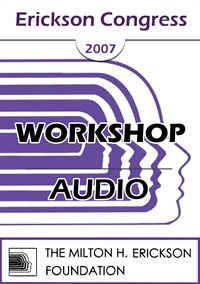
- Average Rating:
- Not yet rated
- Topic Areas:
- Workshops | Metaphors | Storytelling
- Categories:
- Erickson Congress | Erickson Congress 2007
- Faculty:
- George Burns, MA, PsS
- Duration:
- 1:44:29
- Format:
- Audio Only
- Original Program Date:
- Dec 09, 2007
- Short Description:
- This workshop will provide a unique behind-the-scenes account for applying metaphors in a case example. It will lead you through the processes of why and when to choose a metaphor intervention, how therapeutic stories may be constructed, how they can be employed to address a specific problem, what skill, strategies and techniques they can communicate, and how they can offer outcomes.
- Price:
- $15.00 - Base Price
Tags: Metaphors
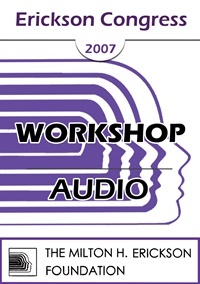
- Average Rating:
- Not yet rated
- Topic Areas:
- Workshops | Cognitive Behavior Therapy (CBT) | Hypnosis | Obsessive Compulsive Disorder (OCD)
- Categories:
- Erickson Congress | Erickson Congress 2007
- Faculty:
- Krzysztof Klajs, Dipl. Psych
- Duration:
- 1:44:09
- Format:
- Audio Only
- Original Program Date:
- Dec 09, 2007
- Short Description:
- OCD affects an estimated 2-3% of the adult population and is recognized by therapist as a difficult and long-lasting disorder. A number of useful strategies for working with OCD will be presented in this session, including the combination of hypnosis with cognitive behavioral strategies in reaction prevention and implosive approaches. Systemic ideas for increasing effectiveness of therapy will be stressed. Time will be allowed for participants to discuss the emotional reactions typically experienced while working with OCD patients.
- Price:
- $15.00 - Base Price
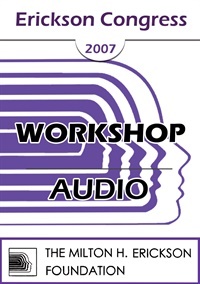
- Average Rating:
- Not yet rated
- Topic Areas:
- Workshops | Unconscious Processes | Therapist Development | Identity | Self-Image Thinking
- Categories:
- Erickson Congress | Erickson Congress 2007
- Faculty:
- Steve Andreas, MA, NLP
- Duration:
- 1:58:02
- Format:
- Audio Only
- Original Program Date:
- Dec 09, 2007
- Short Description:
- This workshop looks closely at how people build a sense of who they are from remembered experiences, imagined futures, and moments of success or failure. Through live demonstrations, it shows how therapists can strengthen self-concept by reorganizing examples across time, helping clients hold mistakes without collapse and carry strengths forward into real situations.
- Price:
- $15.00 - Base Price
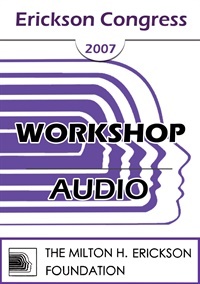
- Average Rating:
- Not yet rated
- Topic Areas:
- Workshops | Meditation, Spirituality and Yoga | Hypnosis | Gender | Femininity
- Categories:
- Erickson Congress | Erickson Congress 2007
- Faculty:
- Lilian Borges, MA, LPC | Marilia Baker, MSW | Consuelo Casula, Dipl. Psych | Betty Alice Erickson, MS, LPC, LMFT | Teresa Robles, MA, PhD
- Duration:
- 1:51:28
- Format:
- Audio Only
- Original Program Date:
- Dec 09, 2007
- Short Description:
- We all have a feminine part and a masculine part, both yin and yang. Whereas the masculine part helps us to control things, analyze things, and make things happen in the world, the feminine part is our guide to, and the connection with our soul. We need ways to resonate with our feminine side in order to have direction, meaning and purpose, and to fulfill our mission in life. This workshop will address how hypnosis and some other strategies can be used to help us resonate with the feminine in our lives.
- Price:
- $15.00 - Base Price
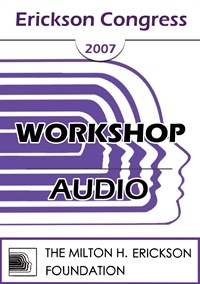
- Average Rating:
- Not yet rated
- Topic Areas:
- Workshops | Therapist Development
- Categories:
- Erickson Congress | Erickson Congress 2007
- Faculty:
- Danie Beaulieu, PhD
- Duration:
- 1:02:20
- Format:
- Audio Only
- Original Program Date:
- Dec 09, 2007
- Short Description:
- Come experience the power of Impact Techniques - for you and your clients. Participants will complete five imaginative and multi-sensory Impact exercises designed for personal growth. Engage your ears, eyes, body and imagination in a lively experience of how simple props, sounds and movements can be used to promote positive personal change. You also will learn how these techniques can be adapted as powerful therapeutic tools for use with your clients, to respond to a wide variety of challenges.
- Price:
- $15.00 - Base Price
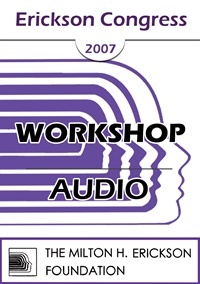
- Average Rating:
- Not yet rated
- Topic Areas:
- Workshops | Core Competencies of Ericksonian Therapy | Ericksonian Hypnosis and Therapy Techniques
- Categories:
- Erickson Congress | Erickson Congress 2007
- Faculty:
- Dan Short, PhD
- Duration:
- 1:58:18
- Format:
- Audio Only
- Original Program Date:
- Dec 09, 2007
- Short Description:
- No matter how hopeless or severe a clinical problem, Erickson always seemed to know of something that could be done. Without a road map to explain their construction, the complexity of his ingenious techniques is intimidating. However, Erickson formulated his overall approach using a few simple strategies. This deeper level of understanding can be learned by almost anyone and is especially important when using powerful therapeutic techniques.
- Price:
- $15.00 - Base Price
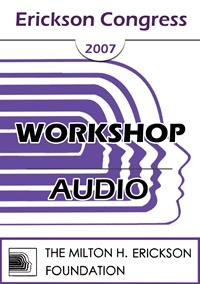
- Average Rating:
- Not yet rated
- Topic Areas:
- Workshops | Panic
- Categories:
- Erickson Congress | Erickson Congress 2007
- Faculty:
- Harriet Hollander, PhD
- Duration:
- 1:55:29
- Format:
- Audio Only
- Original Program Date:
- Dec 09, 2007
- Short Description:
- Eye Closure, Eye Movement integrates the eye movement (EM) component of EMDR within hypnosis. ECEM has application to panic disorder, its associated anticipatory anxiety, and to depersonalization disorder - as a subtype of panic disorder. Hypnotic breathing and other hypnotic techniques, with the addition of EMs, can contain panic, associated anticipatory anxiety and DPD.
- Price:
- $15.00 - Base Price
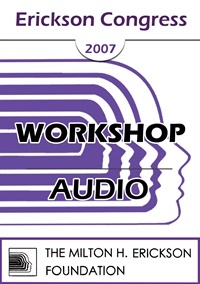
- Average Rating:
- Not yet rated
- Topic Areas:
- Workshops | Hypnosis | Psychology | Psychotherapy | Strategic Therapy
- Categories:
- Erickson Congress | Erickson Congress 2007
- Faculty:
- John Beahrs, MD
- Duration:
- 1:53:36
- Format:
- Audio Only
- Original Program Date:
- Dec 09, 2007
- Short Description:
- Many strategic therapists eschew theory and sacrifice grounding. Missing theory resides in basic sciences. Hypnosis data reveal consciousness and volition as paradoxes, resolvable through evolutionary biology. Human's minds evolved as shared self-deceptions. Theory can predict transference, paradox, game antitheses, Erickson's "common sense psychology," but it constrains their optimum utilization.
- Price:
- $15.00 - Base Price
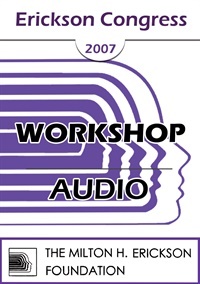
- Average Rating:
- Not yet rated
- Topic Areas:
- Workshops | Hypnosis | Law & Ethics
- Categories:
- Erickson Congress | Erickson Congress 2007
- Faculty:
- Alan Scheflin, JD
- Duration:
- 1:52:29
- Format:
- Audio Only
- Original Program Date:
- Dec 09, 2007
- Short Description:
- Clinicians who practice hypnosis must be familiar with its legal and ethical boundaries. In recent years, courts have paid increasing attention to the clinical and forensic use of hypnosis. Many lawyers have targeted hypnosis as what they call an “experimental and dangerous” type of treatment. We will discuss how therapists may simultaneously protect the legal rights of their patients, and may protect themselves from lawsuits. In addressing current clinical concerns, we will examine the rich and colorful history of hypnosis as it relates to law.
- Price:
- $15.00 - Base Price
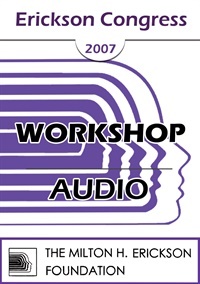
- Average Rating:
- Not yet rated
- Topic Areas:
- Workshops | Meditation, Spirituality and Yoga | Psychotherapy
- Categories:
- Erickson Congress | Erickson Congress 2007
- Faculty:
- Rubin Battino, MS
- Duration:
- 1:56:32
- Format:
- Audio Only
- Original Program Date:
- Dec 09, 2007
- Short Description:
- The systematics of using guided imagery (GI) for psychotherapy and/or healing will be presented, along with the rationale for each component. Using a volunteer, the attendees will participate in creating a GI; then the presenter will carry out what they have designed. If time permits, attendees will experience a generic group GI.
- Price:
- $15.00 - Base Price
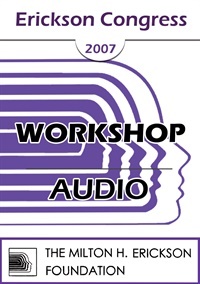
- Average Rating:
- Not yet rated
- Topic Areas:
- Workshops | Addiction
- Categories:
- Erickson Congress | Erickson Congress 2007
- Faculty:
- Robert Dilts, BA
- Duration:
- 1:53:02
- Format:
- Audio Only
- Original Program Date:
- Dec 09, 2007
- Short Description:
- Addictive behavior is the result of inner urges. If the urge is transformed, the behavior will automatically be changed. This workshop explores the structure of addictive responses and how they may be redirected toward more positive outcomes using the integration of language, body and emotions.
- Price:
- $15.00 - Base Price
Tags: Addiction
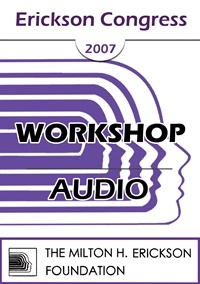
- Average Rating:
- Not yet rated
- Topic Areas:
- Workshops | Ericksonian Hypnosis and Therapy Techniques | Metaphors | Milton Erickson
- Categories:
- Erickson Congress | Erickson Congress 2007
- Faculty:
- Norma Barretta, PhD | Phillip Barretta, MA, MFT
- Duration:
- 1:31:09
- Format:
- Audio Only
- Original Program Date:
- Dec 09, 2007
- Short Description:
- Giulia’s story began almost 30 years ago while Milton Erickson was still with us. He offered amusingly bizarre suggestions to us about what to do with her. Those suggestions lead to several metaphors which helped her to create an escape plan from the “zoo” in which she was trapped.
- Price:
- $15.00 - Base Price
- Average Rating:
- Not yet rated
- Topic Areas:
- Fundamentals of Hypnosis | Hypnosis | Psychotherapy
- Categories:
- Erickson Congress | Erickson Congress 2007
- Faculty:
- Ernest Rossi, PhD
- Course Levels:
- Master Degree or Higher in Health-Related Field
- Duration:
- 2:02:19
- Format:
- Audio and Video
- Original Program Date:
- Dec 09, 2007
- Short Description:
- The four-stage creative process will be facilitated with bioinformatics approaches to therapeutic hypnosis with the entire audience. Adaptations to each individual's needs will be demonstrated with volunteers from the audience.
- Price:
-
Sale is $29.00
price reduced from Base Price - $59.00
- Average Rating:
- Not yet rated
- Topic Areas:
- Fundamentals of Hypnosis | Hypnosis | Self-Image Thinking
- Categories:
- Erickson Congress | Erickson Congress 2007
- Faculty:
- Stephen Lankton, MSW
- Course Levels:
- Master Degree or Higher in Health-Related Field
- Duration:
- 1:44:50
- Format:
- Audio and Video
- Original Program Date:
- Dec 09, 2007
- Short Description:
- Self-Image Thinking (SIT) is a term Lankton coined in 1979 for a cognitive-emotional intervention he uses with clients. SIT is a cognitive-affective rehearsal of experience and behavior that takes advantage of the neurological motto: "What fires together, wires together." This workshop will cover both the SIT protocol and various therapeutic uses of the intervention.
- Price:
-
Sale is $29.00
price reduced from Base Price - $59.00
- Average Rating:
- Not yet rated
- Topic Areas:
- Fundamentals of Hypnosis | Hypnosis | Hypnotherapy
- Categories:
- Erickson Congress | Erickson Congress 2007
- Faculty:
- Stephen Gilligan, PhD
- Course Levels:
- Master Degree or Higher in Health-Related Field
- Duration:
- 2:57:10
- Format:
- Audio and Video
- Original Program Date:
- Dec 09, 2007
- Short Description:
- The “Creative Unconscious” in hypnotherapy can be seen as residing in neither the client nor the therapist, but in the relationship between them. This workshop will explore how the therapists can use their own experiential self to develop this special relationship and use it as part of diagnosis, trance induction, creative problem solving and ongoing feedback.
- Price:
-
Sale is $29.00
price reduced from Base Price - $59.00
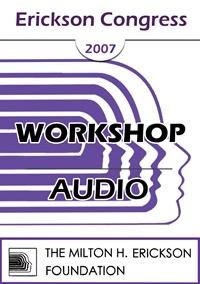
- Average Rating:
- Not yet rated
- Topic Areas:
- Workshops | Dreamwork | Ericksonian Hypnosis and Therapy Techniques
- Categories:
- Erickson Congress | Erickson Congress 2007
- Faculty:
- Ernest Rossi, PhD
- Duration:
- 2:00:12
- Format:
- Audio Only
- Original Program Date:
- Dec 09, 2007
- Short Description:
- Demonstrations of how the ideodynamics of Erickson's hand levitation approach is expanded into a variety of innovative approaches to the replay and positive reconstruction of negative dream experiences.
- Price:
- $15.00 - Base Price
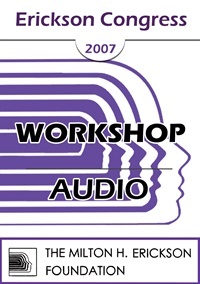
- Average Rating:
- Not yet rated
- Topic Areas:
- Workshops | Unconscious Processes | Hypnotic Induction | Metaphors
- Categories:
- Erickson Congress | Erickson Congress 2007
- Faculty:
- Jane Parsons-Fein
- Duration:
- 1:59:56
- Format:
- Audio Only
- Original Program Date:
- Dec 09, 2007
- Short Description:
- Using a video of Kay Thompson's brilliant conversational induction with a young dentist, we will explore her masterful focus: 1) by studying her own outline of how she uses words and metaphors to lead (and follow) her subject's journey from conscious to unconscious; 2) by looking at the transcript - a map of where she is going; 3) then by watching, as she journeys with her subject through various states from nervousness and confusion to wonder and joy.
- Price:
- $15.00 - Base Price
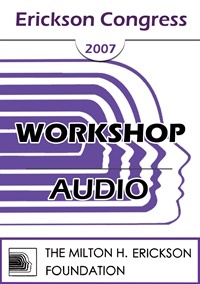
- Average Rating:
- Not yet rated
- Topic Areas:
- Workshops | Therapist Development
- Categories:
- Erickson Congress | Erickson Congress 2007
- Faculty:
- Jeffrey Zeig, PhD
- Duration:
- 1:34:51
- Format:
- Audio Only
- Original Program Date:
- Dec 09, 2007
- Short Description:
- Experiential methods empower therapy. Therapist sculpting is a dramatic method used in the assessment and intervention periods of Therapy. Learn how to "map" the state of the problem and solution, and create therapy goals.
- Price:
- $15.00 - Base Price
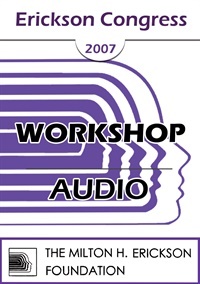
- Average Rating:
- Not yet rated
- Topic Areas:
- Workshops | Consciousness | Hypnosis | Healing | Meditation, Spirituality and Yoga
- Categories:
- Erickson Congress | Erickson Congress 2007
- Faculty:
- Philip Accaria, PhD | Philip Appel, PhD
- Duration:
- 1:34:10
- Format:
- Audio Only
- Original Program Date:
- Dec 09, 2007
- Short Description:
- This workshop offers an immersive introduction to experiential energy work, blending hypnosis, subtle perception and hands-on exercises. Participants learn to sense energy fields, notice shifts linked to emotional states, and experiment with seeing and hearing symbolic information that emerges from these impressions. Through live demonstrations of chakra work, muscle testing, and guided partner exercises, the session encourages curiosity, intuition and embodied awareness, giving clinicians a vivid taste of how energetic methods can deepen therapeutic presence and connection.
- Price:
- $15.00 - Base Price


